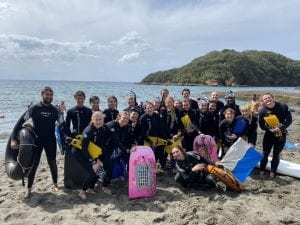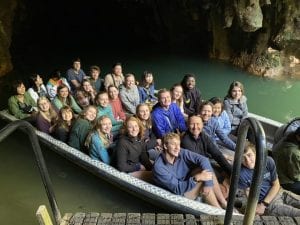Wow! Our second week has already come and gone! This last week has once again offered many opportunities for learning and discovery- way more than I could possibly fit in a single blog post. Though if I had to name a few highlights, I would be apprehensive to neglect our snorkeling expedition at the Goat Island marine reserve, our glow worm sighting at Waitomo Cave, and of course I would be committing a highly insensitive faux pas to all the religiously devoted rugby fans if I forgot to mention our visit to the Sky Stadium to watch the New Zealand Hurricanes take on the South African sharks!
Though for the remainder of this week’s blog post, I would like to offer a little insight into New Zealand’s environmental public policy. What are some of New Zealand’s most imminent environmental concerns? How has Maori culture influenced and been impacted by these said issues?
New Zealand is often deemed an environmental haven. With 1/3rd of its rich biodiversity legally protected, 6 ramsar sites (wetlands that are considered internationally significant), and some of the oldest national parks in the world (one of which we visited called Tongariro National Park), I personally neglected to consider what less desired qualities may be hiding under this pristine facade.
Over 4,000 species are currently threatened in New Zealand and invasive species remain the number one threat to native ecosystems. New Zealand is also a popular tourist destination, providing obvious environmental repercussions. We were privileged to have Dr. Marie Doole, a senior associate at the Institute of Governance and Policy Studies at Victoria University, enlighten us to the many environmental concerns New Zealand faces. For example, the power dynamic between public and private interests remains greatly skewed- usually benefiting the private sector. While New Zealand has enacted various methods to solve environmentally related issues, often budgets are significantly limited. Along with this, the inevitably fluctuating political spectrum is unfavorable towards long lasting change.
However, I must note that in comparison to the United States, there are many ways in which New Zealand tailors to environmentally conscious amenities. For example, there often exists separate bins for differing waste categories- recycling, compost, etc. even in public parks and temporary living accommodations. Toilets almost always have a dual flush system, and outlets often have individual switches that can be turned off when the outlet is not in use.
I have also been intrigued by the relationship that exists between Pākehā (those of primarily European descent) and the Māori people on managing environmental issues. Māori highly value clean land and water. It is their belief that there exists an interrelationship of all living things and that the wellbeing of a person is determined by their accessibility to natural resources and the present state of such resources. In other words, if you pollute the river, you pollute the person. In 2017, the Māori people established that the Whanganui river hold the legal status of a person.
In all, this week has provided much insight into the policy and regulation aspects related to the environment. While there still remains substantial progress to be made, we were privileged to be able to learn about New Zealand’s environmental concerns. Finally, even though Māori still have a long way to go before receiving proper government representation, much can be learned from the progress that has been made.
-Natalie


